By Beth Buehler
It’s funny how the word meeting can either evoke dread or prompt anticipation. Anyone who is charged with the duty to plan a meeting has the ability to steer the ship either direction, so lets aim for inspiring attendees by looking at 10 best practices.

Dial into the purpose. This should be the number one consideration when you plan a meeting. For example, is it a meeting of the minds, release of a new product, an executive level retreat, a sales team gathering or an annual conference? Or it might be a client gathering that provides education on a particular topic of interest. Know it, understand it, and build it into planning initiatives.
Know the attendees. How many people will be attending and are they expecting a formal or informal format? What are their job types or will there be a variety of professions in attendance? A meeting planned for doctors, attorneys and scientists is sure to look a bit different than for tourism, marketing and entertainment professionals. Consider where they will be traveling from, as that will impact start and end times and how many days to schedule. It’s also important to know their appetite for activities. When meeting in Colorado, for example, will they want to tap into the wide array of outdoor activities, brewery and distillery tours, cultural attractions, festivals and professional sports?
Set the stage. Recently, I wrote an article about event branding for an upcoming issue of Colorado Meetings + Events. Both meeting planners I interviewed mentioned the importance of clearly communicating the meeting itinerary and associated activities so that attendees know what to expect and can prepare accordingly. It’s also the perfect place to build excitement. The 2018 Colorado Governor’s Conference on Tourism has been sending out regular e-blasts that tie in a colorful conference logo, provide a “taste” of what is on the schedule and offer opportunities for add-on activities, such as working on area trails for a few hours.
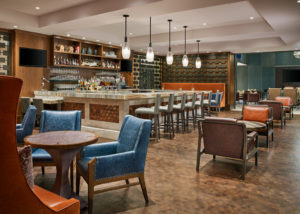
A great place for networking after meetings at Hotel Talisa, Vail’s Gessner Bar. Courtesy Hotel Talisa.Find the right venue and destination. For some groups, it will be convenience and budget that drive venue and destination choices. Regardless, meetings also must tap into the personality and preferences of your group. Ideally, you want attendees jazzed when they hear about the meeting location either because it’s close or someplace they want to visit. The size of your group also is a factor, as not all communities can comfortably host 1,000+. Destination Colorado’s website is a handy tool to preview the options by town, type and size of property, suppliers, etc. Plus, there is an easy RFP process that allows meeting planners to fill out just one form that is forwarded to communities, properties and service providers that fit the parameters outlined.
Plug into the place. Once a destination is located, the fun part is connecting your group to neat experiences in the community. Ask the local destination marketing organization and your hotel sales and conference teams for ideas. For example, when the Colorado Association of Association Executives held a conference in Crested Butte, they plugged into the fact that the town is the Wildflower Capital of Colorado and offered tours with a scientist from the local Rocky Mountain Biological Laboratory. Plus, there were opportunities to explore local trails as the town also is the birthplace of mountain biking along with Marin County, California. In Fort Collins, incorporating the town’s rich beer culture is nearly a must, whether it is a beer tasting at your venue or heading off-site for brewery visits.
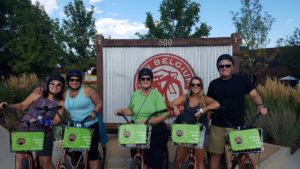
A stop at New Belgium Brewing Company in Fort Collins. Courtesy Beer and Bike Tours.
Make it comfortable and valuable to attend. At large conferences, sometimes being a first-time attendee can be a bit awkward. I like that several meetings are having breakfasts or receptions for first-timers so they can meet a few people right away and figure out how to plan their time and sign up for activities. Kicking off with a reception also is a good way to get the energy flowing and people excited about being at a meeting. Along with networking opportunities, content is king at meetings. People need to go away with information and a vision of how to implement ideas into their own jobs and teams. Also, make sure people know what attire is expected or if people should bring certain gear for activities.
Provide time for networking and enjoying a breath of fresh air. It can be tempting to pack an agenda full when there is limited time, but don’t underestimate the value of free time for networking, exploring and going out on the patio for a morning or afternoon break. The concept of mindful meetings is still very much in the forefront, and many conferences are now offering designated spaces where you can chill out for a bit in a quiet space, get a chair massage, enjoy a cup of tea or a smoothie, and relax on comfortable furniture.
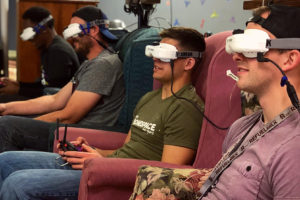
Take a break from meetings at Colorado Springs’ new DroneSpace where attendees can race drones. Courtesy VisitCOS.com.
Make the most of culinary opportunities. Sorry, but if the food is bad or lacks appeal, the attendees get cranky. I love that the food scene at meetings has gotten creative. I’ve noticed that breakfast has finally gotten interesting with company and conference logos showing up in unexpected places like pastries and the first meal of the day being more inspired when there is a DJ or a local high school marching band. At IMEX last year, there was even a coffee artist that drew my portrait on a cup of joe! At ILEA Live in Denver, there was a pre-conference Chopped Kitchen Challenge option that involved teams of attendees and the hotel’s chefs. One of the highlights at a conference reception at the History Colorado Center were three food areas highlighting skiing and the Rocky Mountains, Red Rocks Amphitheatre and the music scene, and the artsy River North Arts District.

A coffee artist at IMEX, where you can find a Destination Colorado booth every year! Photo by Beth Buehler.
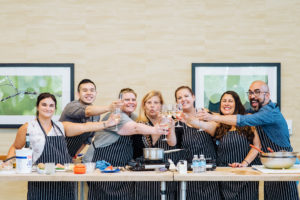
Chopped Kitchen Challenge during ILEA Live. Photo by From the Hip Photo.
Document the meeting. It’s always helpful to have ways of sharing information with attendees and those who cannot be present through notes, PowerPoint presentations and video recordings. There are even artists in Colorado who specialize in documenting meetings and events in a fun, visual way. Churches do an amazing job building community by posting worship services online so members and people beyond can be plugged in. How are you plugging in your people?
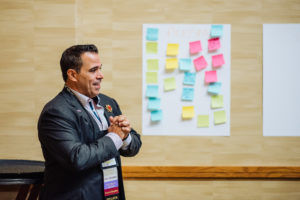
Documenting input during 2018 ILEA Live held in Denver. Photo by From the Hip Photo.
Help attendees leave with a sense of accomplishment and follow up. Ever leave a conference on fire for a cause or your company and filled with ideas but quickly get back into your same old routine? Thank attendees for attending and for their contributions to dialogue, provide links to photos and speaker presentations, and offer a survey to gather input. Recently, I received a “Unifying the Live Events Industry” report that followed up a major topic of discussion that took place in conjunction with the ILEA Live conference mentioned earlier. Two months later, it reminded me of the conference and provided further information to ponder. Find ways to continue the conversation!
I hope that at least a few of these tips for better meetings are helpful. Meetings are an important part of human interaction in corporate, nonprofit and association worlds, so let’s make them worthwhile and rewarding gatherings that inspire people to attend!
Beth Buehler is editor of Colorado Meetings + Events and Mountain Meetings magazines, has helped plan numerous meetings and events, and enjoys exploring Colorado in all seasons.
